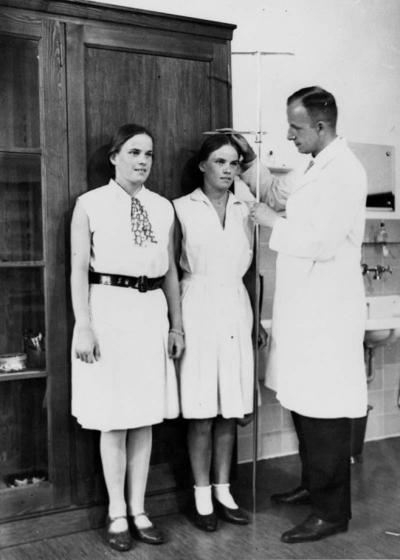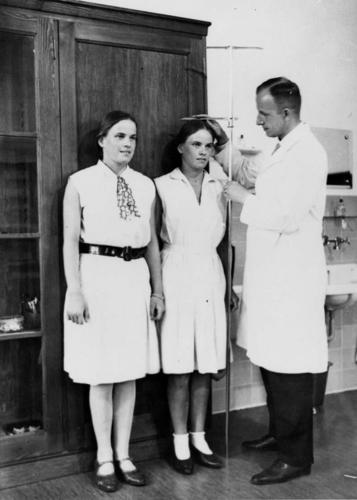America’s pseudo-scientific crusade (during roughly the first half of the century) to create a white, blond, blue-eyed, biologically superior “master race” was a misguided 20th-century quest called eugenics. More than 27 states joined the shameful, decades-long utopian campaign to medically engineer racial supremacy.
But only one state, North Carolina, is now readying a massive plan of financial reparations to its surviving victims. Just how much North Carolina should pay is the subject of a historically wrenching debate, even as the state grapples with its budget deficit.
Eugenics was a fraudulent theory claiming that a better society could be created by eliminating “undesirable” human bloodlines, while promoting the “desirable” types. This dark crusade was waged by blinded progressives and do-gooders seeking utopia. In Greek, the word utopia means “nowhere.”
Race science sprang to life in the convulsive first decade of the 20th century, during which Asians, Eastern and Southern Europeans, Mexicans, Native Americans, blacks, and other ethnic groups flowed into U.S. cities, creating overcrowding. The intellectual, academic, scientific, and financial elite – many of them wealthy livestock breeders – believed better humans could be cultivated using the same techniques as a farmer would to create a better herd of cattle or field of wheat: eliminate the bad stock and proliferate the good.
They planned to eliminate all those who did not resemble themselves, 10% at a time – that is, as many as 14 million people at a slice. Their eventual goal was to eliminate as much as 90% of the population from the reproductive future of America.
The preferred methods were gas chambers and other forms of euthanasia. The first public euthanasia legislation was introduced into the Ohio legislature in 1908. That measure was unsuccessful, as were other death panel bills. The next best thing was forced surgical sterilization under specific state authority. This policy in many states was validated as the law of the land in the U.S. Supreme Court by one of America’s most stellar jurists, Oliver Wendell Holmes. In 1927, Holmes ruled on an obviously collusive lawsuit seeking to justify the forced sterilization of Carrie Buck, her mother, and her healthy daughter.
“It is better for all the world,” Justice Holmes infamously wrote, “if instead of waiting to execute degenerate offspring for crime or to let them starve for their imbecility, society can prevent those who are manifestly unfit from continuing their kind … Three generations of imbeciles are enough.”
Ultimately, more than 60,000 Americans, mainly women, were coercively sterilized. Many victims were tricked into thinking it was a harmless procedure. California led the nation in the number of such sterilizations, all taxpayer funded. Ohio for decades was a wellspring of eugenic agitation, but various sterilization bills were never passed, or those passing both state houses were vetoed by the governor.
America’s eugenics movement, powered by the opulent Carnegie Institution, The Rockefeller Foundation, and the Harriman railroad fortune, sought to extend its reach into Germany. Rockefeller and Carnegie spent Depression-era millions to finance the worst Nazi doctors and race institutes. Hitler promptly implemented American precepts with stunning ferocity and velocity. Among the chief recipients of Rockefeller money was top Nazi doctor Otmar von Verschuer. During the Holocaust, Verschuer’s assistant Josef Mengele continued Rockefeller’s research on twins at Auschwitz.
Eugenics and forced sterilization were repugnant enough to be deemed genocide from the first moments that the term came into use.
In the tear-stained ashes of post-Nazi Europe, Americans recoiled at the fruit of their official raceology. Collective amnesia set in. Eugenics was renamed and reinvented as the new science of genetics. States began repealing or dead-lettering their eugenics laws, from marriage prohibition, to compulsory confinement in special colonies, to state-ordered sterilization.
North Carolina, however, continued its eugenic practices for years, with race laws purportedly deployed to eliminate poverty. From 1946 to 1968, an estimated 7,600 additional North Carolinians were sterilized, mainly poor blacks. Now, the state of North Carolina, under the weight of a multi-billion dollar deficit and a rising black political power base, is struggling to augment its official apology with financial compensation.
Some have suggested $20,000 per survivor. Others suggest $50,000. An estimated 2,900 victims may be qualified. But can society right a wrong by merely writing a check?
The true victims of this tragic national disgrace are not only the survivors now telling their stories, but millions more never born. How do you compensate people and families who never existed because of pernicious eugenic laws that criminalized interracial marriage, murdered helpless patients by institutional medical abuse, and sterilized unwanted segments of entire generations?
While money to victims who present themselves can constitute a token of governmental remorse, the best compensation is illumination. Spend resources to document the crime, teach the revelations in our schools, and ingrain the strain, so that the next wave of race scientists will be met with the historical imperative: “never again.”
Then the checks can actually make a token down payment on righting a wrong.
Edwin Black is the best-selling author of IBM and the Holocaust and the eugenic chronicle War Against the Weak. See www.edwinblack.com and www.waragainsttheweak.com.






